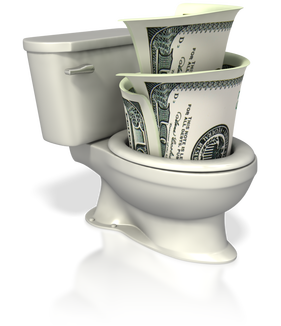Toilet Leaks
If your toilet runs for a long time or suffers from an occasional "phantom" flush, you may have a leak. More than 20 percent of gravity-flush toilets leak.
Follow these tips to find and stop toilet leaks. If you are not sure about your ability to perform any of these steps, please consider contacting a licensed plumber.
Note: These tips pertain to traditional gravity-flush toilets and not high-efficiency toilets. Periodic Refills Without Flushing "Ghost" or "phantom" flushing is usually the result of a worn rubber flapper that is allowing water to seep from the tank into the bowl and down the sewer. An improperly adjusted flapper chain also could cause the problem. |
Conduct a simple dye test to see if water is seeping from the tank. Use food coloring or a powdered drink mix to noticeably color the water in the toilet tank.
- Place the dye tablets or coloring agent in the toilet tank.
- The tank water will change color, while the toilet bowl water should be clear.
- Wait 10 minutes.
- Check to see if any coloration appears in the bowl. If so, then you have a leaking flapper valve.
Continuous Trickling A continuous trickling sound usually means water is running over the top of the overflow tube inside the tank. Follow these steps to help resolve the issue.
Remove the toilet tank lid and conduct a visual inspection. Flush the toilet and observe the process. Look for obvious problems.
Check to see if the refill water level is set properly and does not rise over the top of the overflow tube.
To lower the water level, adjust the float lower.
On a bulb-on-arm style toilet, adjust the screw near where the float arm attaches to the float valve.
On newer valve and float units, adjust the float by moving the float downward on the vertical rod.
If the toilet continues to run, even with the float adjusted, you should replace the refill valve with a new unit from your local hardware store.
Replacing Worn Parts Turn off the water supply valve to the tank. This is usually located on the wall under the toilet. Flush the toilet to drain the water.
Select appropriate replacement parts from the hardware store and follow the manufacturer's directions to install them.
After installing the parts, turn the water on and test-flush the toilet once or twice. If you replaced the flapper, perform the dye test again to ensure the flapper fits properly. Not all flappers fit properly in all toilets so you may still have a leak.
In some cases, a leaking flapper may be the result of a worn surface on the seat against which the flappers rests. You can try smoothing the seat with steel wool or a scouring pad. If this doesn't correct the problem, you may need to replace the flapper seat and overflow tube assembly.
Most major plumbing manufacturers have detailed assistance on their websites as well as toll-free telephone numbers to call for assistance.
